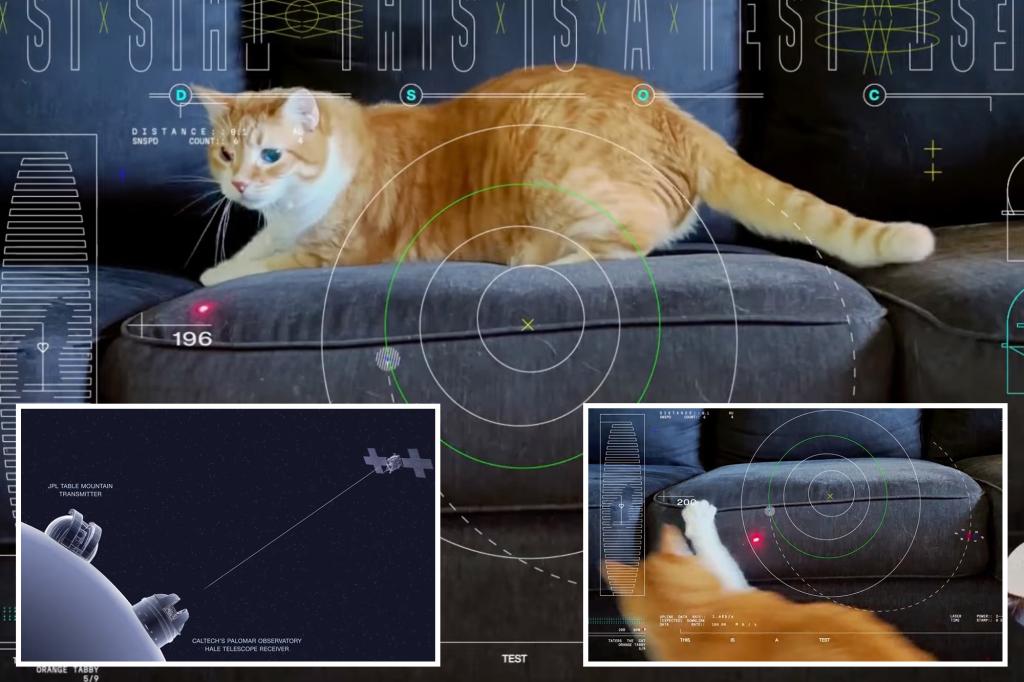Earth to Mars: It’s Taters the Cat.
An adorable video of an orange and white tabby cat made history after it was beamed down to Earth from a spacecraft traveling through space.
In the first attempt of its kind, a 15-second clip of Taters was sent from NASA’s Psyche spacecraft 19 million miles away on Dec. 11 and downloaded faster than most internet connections on Earth.
“Despite being sent from millions of miles away, it can deliver video faster than most broadband internet connections,” Ryan Rogalin, who worked on the project, said in a statement.
The high-definition footage was sent from Psyche as it traveled through the asteroid belt between Mars and Jupiter. The recording was sent through a new state-of-the-art laser instrument and took just 101 seconds to reach our planet.
Scientists hope the technological breakthrough paves the way for the next scientific breakthrough: humans traveling to other planets.
“Increasing our bandwidth is critical to achieving our future science and exploration goals, and we look forward to the continued advancement of this technology and the transformation of how we communicate during future interplanetary missions,” said NASA Deputy Administrator Pam Melroy.
The orange and white tabby cat, Taters, can be seen hopping around the couch to catch a red laser dot in typical feline fashion, a 15-second video uploaded by NASA shows. YouTube/JPLraw
Researchers in the project said they usually send “randomly generated test data packets” but this time decided to use Taters’ video.
“To make this important event even more memorable, we decided to work with designers at [Jet Propulsion Laboratory] to create a fun video, which captures the essence of the demo as part of the Psyche mission,” said Bill Klipstein, project manager of the technology demo.
The The 15-second video was recorded on Earth and shows Taters jumping around the couch to catch the red laser dot.
The Taters video was uploaded before the launch of the Psyche mission on Oct. 13. The footage includes graphics across the screen, including “this is a test” and also Taters breed and heart rate, as well as, Psyche’s orbital path, among others.
While the video may look like many other cat videos on the internet, this video was beamed down to Earth from 19 million miles away on Dec. 11. YouTube/JPLraw
Tates made his space debut via an instrument called a flight laser transceiver, which beamed a “coded near-infrared laser” to the Hale Telescope at Caltech’s Palomar Observatory in San Diego County, California.
NASA’s Deep Space Optical Communications Experiment is beaming “ultra-high-definition streaming video” as part of a project it hopes will enable “future human missions beyond Earth orbit,” a press release said.
The video is downloaded at the observatory and then sent “live” to the company’s Jet Propulsion Laboratory in Southern California, where the video is played in real time.
Tates made his space debut via an instrument called a flight laser transceiver, which beamed a “coded near-infrared laser” to the Hale Telescope at Caltech’s Palomar Observatory in San Diego County, California. The video took 101 seconds to reach Earth, where it was then downloaded at the observatory and then sent “live” to the company’s Jet Propulsion Laboratory in Southern California, where the video was played in real time. X/@NASAJPL Video Taters was uploaded before the launch of the Psyche mission on Oct. 13. The video includes graphics across the screen, including “this is a test” and also Taters breed and heart rate, as well as, orbital path, among others. NASA/JPL-Caltech
Taters — who “everyone loves,” according to Rogalin — belong to the Jet Propulsion Laboratory’s employees.
The cat was chosen because the team was inspired by a TV test broadcast in 1928 that showed Felix the Cat. Also, cat videos are quite popular online.
Categories: Trending
Source: thtrangdai.edu.vn/en/



